INDUSTRIAL &
TERMINAL RAILROADS &
RAIL-MARINE OPERATIONS
OF BROOKLYN, QUEENS, STATEN
ISLAND, BRONX &
MANHATTAN:
Starrett Lehigh Liggett Building Twenty Seventh
|
WEST 27TH
STREET FREIGHT STATION & RAILROAD
PIER 66 Manhattan, NY
LEHIGH VALLEY
RAILROAD
|
|
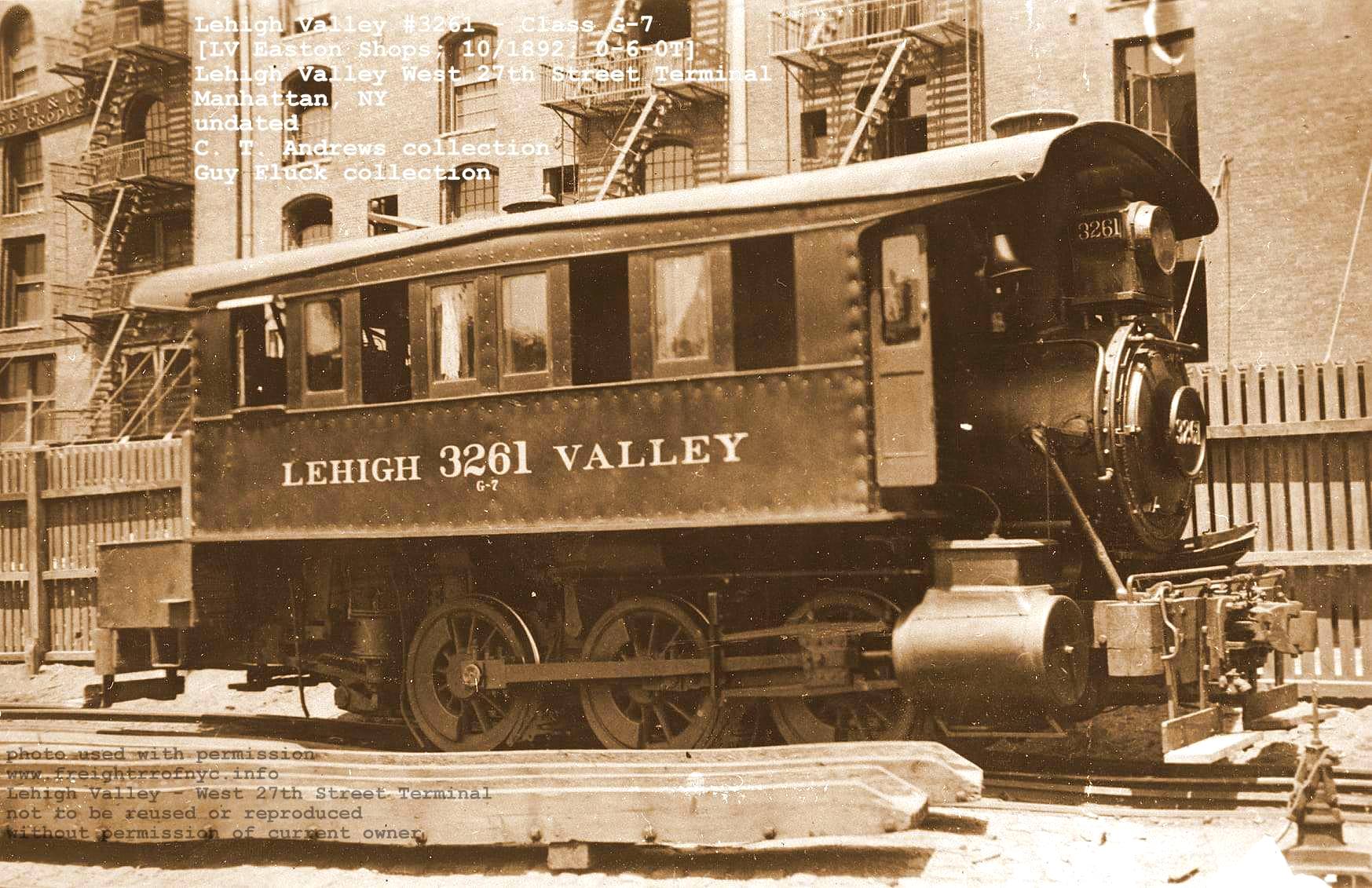
|
updated: |
||
|
|
||
|
update summary: |
date: | chapter: |
| LV 3261 and 3354 added | 08 April 2021 | Locomotive Overview & Photos Locomotive Roster: builders data, disposition info |
.
.

| Property & Trackage | Starrett - Lehigh Building | Liggett Building | Pier Station | |
| Float bridges | Locomotive Roster builders data, disposition info |
Marine Equipment Overview & Roster |
.. ..

1924 Army Air Service
courtesy of T.
Flagg
added 27 June 2009
.
It is stated that the Lehigh Valley Railroad opened the West 27th Street Freight Yard for service in 1905, however, according to an entry in the Thirtieth Annual Report (year ending December 31, 1900) of the City of New York Department of Docks and Ferries; a transfer (float) bridge was constructed in front of the bulkhead between piers 56 new and 57 new by the Lehigh Valley Railroad. Work was begun May 26, and finished by December 31, 1900. Preparatory work on the bulkhead was started in March of that year.
According to the 1920 Joint Report with Comprehensive Plan and Recommendations by the New York, New Jersey Port and Harbor Development Commission; the following figures are given.
Lehigh Valley Railroad - West 27th Street
|
tonnage handled |
... |
cars handled |
... |
cars handled |
||||||
| inbound |
outbound |
total |
loaded |
empty |
total |
loaded |
empty |
total |
||
|
|
|
|
||||||||
| 23,760 |
14,160 |
37,920 | 2,167 |
833 |
3,000 |
2,009 |
991 |
3,000 |
||
.
A Fairchild Aerial Survey Photo shows this yard to be active in 1924:

Fairchild Aerial Survey Photo -1924
NYPL Digital Archives
.
The Lehigh Valley Railroad's West 27th Street Freight Yard is believed to have have been closed prior to 1930, but rebuilt under the Starrett - Lehigh Building for direct service to the buildings tenants.
Lehigh Valley Railroad freight service would be discontinued at this location in 1966, although it is believed the Pier Station service was eliminated prior to this date.
The Starrett - Lehigh building is a New York City Landmark, and remains to this day, although the railroad tracks on the ground floor have since been removed.
The image below, is an inset from a 1956 Lehigh Valley System Map, shows the various carfloat and lighterage routes in the New York City area. Of particular note is the service to "West 27th Street Yard", which by this time is under the Starrett - Lehigh Building. Also noted are the routes to Pier 38 and Pier 8 of the Hudson River, and Pier 44 and the East 34th Street Station on the East River. I am assuming that the line heading up the East River past the Queensboro Bridge leads to the Bronx Terminal.
It is also interesting on how the independent offline terminals (Brooklyn Eastern District Terminal, Jay Street Connecting, New York Dock and Bush Terminal are listed.

Lehigh Valley System Map - 1956
..
.
The following article was discovered within the Official Proceedings of September 1900 for the monthly meeting of the Western Railway Club. In this discussion, it specifies the design of the trackage used at the West 27th Street Freight Station:
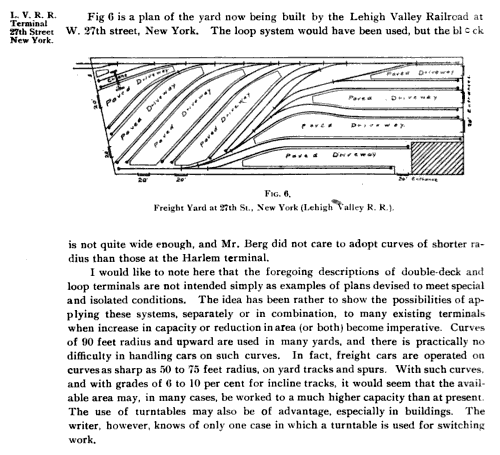
Official Proceedings of the Western Railway Club -
September 1900
added 22 October 2010
.
The Lehigh Valley Railroad West 27th Street Freight Yard would be the most spartan of Manhattan's West Side railroad facilities, and the first to close, albeit being somewhat rebuilt under the Starrett Lehigh Building in 1931.
In the Western Railroad Club diagram above and the 1909 Property Map below, and it would consist mostly of team tracks with single solitary freighthouse located in the southeast corner of the property, on the corner of Eleventh Avenue and West 26th Street.
This original freight house can be seen in the lower left (southeast) corner of the property. According to the legend on the Bromley map index, pink structures denote brick construction, yellow structures are wood frame construction, stone / concrete construction in light brown, and iron or metal sheathed wood construction is yellow with blue outline (i.e. pier).
I have included these construction types to give the reader a better sense of the many types of structure compositions that existed in these freight terminals.

G. W. Bromley 1909 (revised by author)
historicmapworks.com
.
On 21 June 2010, Jim Guthrie forwarded the Port Facilities Map from 1924. Here is the portion showing the Pennsylvania West 27th Street Freight Yard:.

Army Corp of Engineers Port Facilities Map - 1924
courtesy of J.
Guthrie
added 22 June 2010
.
.
This trackage would remain, for the most part unaltered, until ca. 1930. It is not known, whether service to the West 27th Street Lehigh Valley Freight Yard was halted for the construction of the Starrett Lehigh Building, or whether that building was constructed in sections, allowing Lehigh Valley to maintain a portion of the yard in service, until one section of the building was completed, and the Lehigh Valley moving to the new trackage, whilst construction of the building then moved to the old "yard".
.
.
Photos below taken in 1931, show the Starrett - Lehigh Building under construction at the location of the former Lehigh Valley West 27th Street Freight Yard
These photos show that even after the Starrett - Lehigh Building was completed, the Lehigh Valley Railroad float bridge was still in place with a carfloat attached.
This was not understood until I researched the history of the Starrett - Lehigh Building:
.
New York Architecture Images - Chelsea, Starrett
- Lehigh Building
(
http://www.nyc-architecture.com/CHE/CHE008-Starrett-Lehigh%20Building.htm
)
"This massive factory-warehouse offered a novel solution to freight distribution and a dramatic example of curtain wall construction. With tracks leading directly from the piers into the building, freight cars carried by boat from New Jersey could be moved in 30-foot elevators to truck pits on upper floors."
"The 2.2 million-square-foot Starrett-Lehigh Building was completed in 1932 the freight distribution building originally had a railroad as its ground floor occupant."
.
The Starrett - Lehigh
Building
( www.starrett-lehighbuilding.com/home.html )
I also located the following May 31, 1998 New York Times article on the Starrett - Lehigh Building by Christopher Gray:
"By the 1920's, New York businesses were regularly lamenting the cost of traffic delays, but matching the forms of 19th-century buildings to the modern city of truck, railroad and barge transport was hard to achieve. In 1930 William A. Starrett, a prominent financier-builder, leased the block bounded by 26th and 27th Streets and 11th and 12th Avenues from the Lehigh Valley Railroad, which operated an open-air freight yard on the site served by car floats docking at Pier 66 across 12th Avenue.
The railroad retained the ground floor as a vast freight yard, and the 19-story, 1.8 million-square-foot building Starrett put up directly above it provided the railroad with a large pool of potential customers.

(authors reconstruction of an actual
diagram)
Trucks pulled into driveways from 27th Street, descended to a bay of three giant elevators in the basement and were carried to particular floors for deliveries or pickups. On the way out, they were brought down and exited at grade level, to 26th Street.
Inside, the floors were wide open -- long forests of mushroom columns recessed from the perimeter, an 8-foot-high strip of steel casement sash. On the outside, the architects Cory & Cory made the simplest possible statement: ribbon windows alternating with plain brick bands. The engineers for the Starrett-Lehigh Building were Purdy & Henderson....
Lewis Mumford, writing in his ''Skyline'' column in The New Yorker in late 1931, called the Starrett-Lehigh Building ''a victory for engineering'' and said that ''the contrast between the long, continuous red-brick bands and the green-framed windows, with sapphire reflections or depths, is as sound a use of color as one can see about the city.''
Mumford objected only to the ''rabble of water tanks'' on the roof and to the central bay, expressed with the vertical line of a traditional skyscraper, which he said spoiled ''the noble severity'' of the facade.
Early Manhattan address-telephone directories list as tenants in the building the types of businesses that might need boxcar-size shipments: Standard Pressed Steel, the Il Duce Wine Company and the Wheeling Tire Company. They also list Buckminster Fuller -- at the time he was experimenting with mass-produced kitchen/bathroom combinations.
Starrett died in March 1932, and the Lehigh Valley Railroad bought the building that June.
In 1935 the railroad reported to the Interstate Commerce Commission that the building had been losing money, more than $300,000 in 1933.
Thomas Flagg, an industrial archeologist, said that by 1943 the building was 100 percent occupied. But, he said, rail freight served by car floats ''could not compete with the tax-supported public roads'' in the 1950's. In 1966 the railroad gave up its ground floor, and the tracks were torn out for a trucking operation.
.
Starrett - Lehigh Building - Eleventh Avenue & West 27th Street - July
14, 1936
(note the sign on this building and the writing on the white building to
the left!)
B. Abbott photo
NYPL Digital Archives
.
.
Liggett Building / shared
access with Erie Railroad
.
The map shown below, dated 1933; it shows an accurate representation of the vast trackwork both in / under the Starrett - Lehigh Building, and the connecting street trackage to both the Liggett Building, and the Erie / Erie - Lackawanna float bridge due north.

Port New York Authority - 1933
Port Authority of New York New Jersey archives
(Original map destroyed 11 September 2001 in World Trade Center.
A copy was fortunately made by T. Flagg!)
T. Flagg
archives
added 30 Apr 2009
Army Corp of Engineer Port Facilities Maps of 1953 and 1965, show that two tracks come off the Lehigh Valley Railroad float bridge with and split into three tracks:
Both the southern track (the track with turnout on float bridge for the center track of three track carfloats) and northern track of the Lehigh Valley Railroad float bridge went directly across Twelfth Avenue and entered the Starrett - Lehigh Building (#38).
However, the northern track (highlighted in red below) had a turnout just east off the float bridge, and this single track veered north and split into two tracks just before entering another building (#39 - Liggett Building) located between West 27th and West 28th Streets. This double track was connected to the Erie / Erie Lackawanna West 28th Street float bridge:
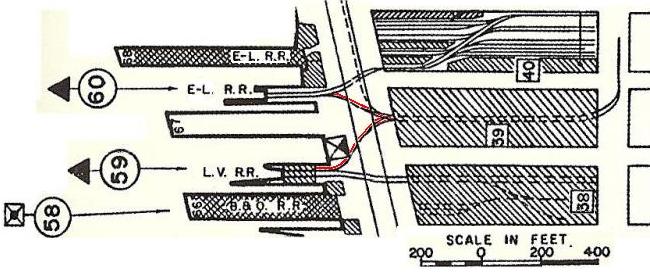
Army Corp of Engineers Port Facilities Map - 1965
.
It is clear that the Erie / Erie Lackawanna Railroad could serve this building #39 (Liggett Building) in addition to Lehigh Valley. However, this is a very unusual arrangement, as offline railroad terminals did not usually interconnect with the "competition".
Prior to the installation of the trackage accessing the Liggett Building from the Lehigh Valley and Erie Railroads, this build was served via the New York Central "Eleventh Avenue Freight Line" (surface / street trackage).
When the New York Central constructed the "High Line", the Eleventh Avenue trackage was abandoned, and the Liggett Building was connected into Lehigh Valley and Erie Railroad's trackage to maintain service.
.
The Lehigh Valley Railroad occupied Pier 66 on the Hudson River.
This Pier Station had a full length covered pier, and carfloats would be moored directly to the pier for the loading and unloading of freight directly from the freight cars into and out of the pier shed.
It is understood both carload and less than carload freight consignments were transferred to and from this Pier 66.
The 1965 Army Corp of Engineer Port Facilities Map shows that Pier 66 in now labeled for the Baltimore & Ohio Railroad, therefore it is concluded that the Lehigh Valley Railroad relinquished Pier 66 to the Baltimore & Ohio Railroad.
|
|
| .
. |
|
|
| .
. |
|
|
| .
. |
|
|
| .
. |
|
|
.
.
According to Thirtieth Annual Report (year ending December 31, 1900) of the City of New York Department of Docks and Ferries; there are multiple entries concerning the construction of a transfer (float) bridge by the Lehigh Valley Railroad at West 27th Street:
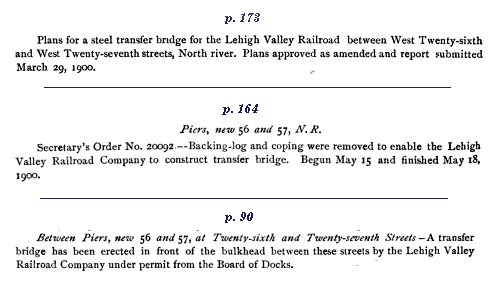
Thirtieth Annual Report (year ending December 31, 1900)
City of New York Department of Docks and Ferries
(composite of several
entries)
added 01 July 2009
.
.
From this, we now know that the first float bridge intended to be installed at West 27th Street was in fact a steel bridge, and not a Howe Truss. Yet in the 1931 image of #111 above, the tall timber of a Howe Truss can be discerned in the image as well as photos of other locomotives below at the float bridge show a Howe Truss as well!
However, back tracking a little and looking carefully at the 1924 Fairchild Aerial Survey Photo at the top of this page, shows a low (minimal shadows) two girder span. Previous research has shown a Howe Truss float bridge was always constructed with a center truss for a total of three tall trusses (which have a distinct shadow signature in aerial photos).
So, it appears the steel float bridge was replaced with wood Howe Truss between 1924 and 1931.
This Howe Truss would remain in service until the closure of this facility.
As for the exact date the float bridge was removed is unclear. The float bridge is visible in a 1966 aerial photo, the same year service ended at this facility.
The float bridge is removed by a 1979 United State Geological Survey aerial photo.
Lehigh Valley Railroad / Erie Railroad Shared Access
An interesting sidebar to the history of this float bridge location, is the fact the Erie Railroad used the Lehigh Valley float bridge to access the Erie Railroad West 28th Street Freight Station, until Erie could construct a float bridge of their own:

.
Steam Locomotives
#3500 (?)
This author, in the process of searching the internet for Lehigh Valley steam switching locomotives, came across an image of an 0-4-0T. This photo of #3500 appears to have been taken streetside with the possibility of also being dockside. Unfortunately, the location or the date taken of this photograph is not denoted.
This in turn, led to an in-depth search of various builders records in the author's possession, for Lehigh Valley steam locomotives of 0-4-0 or 0-6-0 wheel arrangements. Surprisingly, this search revealed a few switching locomotives of those wheel arrangement and of side or saddletank type.
#3500 being a 0-4-0T, is most suitable for use at the Bronx Terminal location and with it, the West 27th Street Freight Yard, and the photo below appears to have certain elements that would be seen at a street and waterside terminal. In the image below, take note of the lamp post on what appears to be a dock or wharf, with what appears to be a basin of water behind the handrail and behind the locomotive. This photo could be taken in either the Bronx or Manhattan.
I have attempted to contact the owner of the photo of #3500 (Railway Excess Agency), but my emails are getting returned as undeliverable. The owner has listed the image as believed to be out of copyright, so I have posted that image in the roster below. On the off chance that the owner finds this webpage and sees that image, please contact me at bedt14@aol.com.
Unfortunately, it cannot be positively confirmed at this time if #3500 was indeed used at either the Bronx Terminal or West 27th Street locations. None the less, builders information for #3500 appears is included in the roster below because it is the most likely candidate.
.
#3205, 3354 (!), 3357, 3358 and 3359 (?)
There were several 0-6-0T locomotives owned by the Lehigh Valley Railroad.
The first of these, I can find no information on other than an image. #3205 was a 0-6-0T, Lehigh Valley class G1.
The confirmed 0-6-0T locomotives were #3354, 3357, 3358 and 3359. Some of these were equipped with flanged center drivers, which might not have been suitable for tight radius curves of the type that would be encountered in the Bronx Terminal trackage, but could have very well been used at this location in Manhattan.
With thanks to Guy Fluck, we know can confirm that the 0-6-0T's did in fact operate in Manhattan. He was kind enough to allow use of his image showing #3354 on Twelfth Avenue in Manhattan and dated January 1, 1914. Unfortunately, the photographer is not recorded. Of particular note is the blind center driver and the sublettering on cab "G-20" and "NY", with G-20 denoting the Lehigh Valley locomotive class and NY as its assigned work area. Also note the chalk writing on the boxcar: "27 St" and "Leggett". Leggett was a pharaceuticals, chemicals and insecticide manufacturer located in Manhattan. Also note the light standard over and behind locomotive which confirms street running.
.
Diesel-Electric Locomotives
#100
Pursuant to the initial ratification of the Kaufman Act in 1923, this facility would see the acquisition of one of the new A/GE/IR boxcabs developed to allow the railroad to comply with the act.
You can read the comprehensive history of all steam locomotive restrictions for the City of New York, beginning 1834 and ending with the Kaufman Act and its repeal on the main page of this website: Steam Locomotive Regulations within the City of New York. It is very much worth a read, because there are misconceptions about the Kaufman Act, i.e. such as it was repealed in 1930.
A photo located on North East Rail's archives shows Lehigh Valley Railroad locomotive #100. This photo is positively attributed to have been taken in the West 27th Street Yard and can be seen below.
Lehigh Valley Railroad #100 was an American Locomotive / General Electric / Ingersoll Rand diesel electric boxcab. This locomotive was built in January 1929, following the success of Central Railroad of New Jersey's #1000, which was the first generation descendant of the Ingersoll - Rand boxcab prototype.
Upon the commercial success of the Central Railroad of New Jersey #1000, many railroads placed orders for boxcab diesel electric locomotives, including this Lehigh Valley #100 which was the third unit constructed, (after Baltimore & Ohio Railroad's #1 used at their West 26th Street Yard one block south) and this locomotive was the only A/GE/IR boxcab purchased by Lehigh Valley.
This unit was built in January 1926 and bore the American Locomotive Company c/n 65981 and General Electric c/n 9683. Design specifications were identical to the Central Railroad of New Jersey and Baltimore & Ohio units, with 300 h.p. and B3-1 body types.
It is unknown to what level of success Lehigh Valley found this locomotive to be, as Mack #111 is seen operating in this facility several years later. Eventually, #100 would be retired by Lehigh Valley in December 1947 and scrapped same year in Sayre, PA.
.
#111 / #51
On 27 March 2009; this author located on eBay an image of Lehigh Valley #50, a Mack switcher. Initial interest in looking any further into the lot, was that that it was of Mack build, similar to the Pouch Terminal Mack switcher. Upon reading the actual item description however, it was learned that the photo was taken at the East 149th Street Terminal in the Bronx!
This discovery led to this locomotive being added to the roster of Lehigh Valley locomotives used at the Bronx Terminal. According to Mack builders records, this locomotive was originally Lehigh Valley #110 and was built in December 1929. Actually, there were two identical locomotives of this type built for the Lehigh Valley Railroad: #110 (renumbered #50) and #111 (renumbered #51).
Both were Model AY 45 ton gas - electrics, three axles (6 wheel) and powered by three Mack 6 cylinder gasoline engines developing 405 horsepower. This Model AY was somewhat larger than that of the Pouch Terminal Model AW switcher, which was a two axle model, and it is unknown if #111 / #51 was used at the Bronx Terminal as well. At some point, Lehigh Valley changed the class of the locomotive from B-3-E to G-2-E.
A web search for Lehigh Valley #111, turned up one photo on NE Rails archives. This photo shows #111 on the apron of a wood Howe Truss float bridge, with a pier in the background. A link to this image was placed on the Bronx Terminal page, the image archived in one of the authors folders on his computer and forgotten about.
.
#112
Lapse forward to 26 April 2009, and I locate an image of Lehigh Valley #112 on a wood Howe Truss float bridge with a pier as background. Needing some assistance in identifying the location, I showed the image to my shifty(!) yet trusty research assistant, Joe Roborecky. In the process of searching the web for Lehigh Valley locomotives he came across the photo of #111. Upon viewing that photo, we both realized that photos #111 and #112 were taken in almost exactly the same location!
I originally thought that the float bridge was too close to the pier to have been at the West 27th Street Freight Yard. In viewing an aerial photo of the Lehigh Valley floatbridge at this location, shows a slip space between the floatbridge and the pier, wide enough for a single carfloat. I concluded (erroneously) that the pier was too close to the float bridge to be the West 27 Street facility.
But Joe pointed out, if you look closely at the image of #112, the top of a boxcar can be seen through the front handrail just above the storage box on the front of the engine, and of which is next to the pier. With this revelation (and the the fact that there is "vignetting" in the photo of #112 in the up right and left corners of the image), it is now believed that telephoto lens compression in the image makes the pier appear closer than it actually is. So the conclusion is this is indeed the float bridge at the Lehigh Valley's West 27th Street facility.
 #3261 - unknown date - West 27th Street Terminal, Manhattan, NY As this locomotive was scrapped January 1919, this photo predates that event. Note the building sign top left corner: " ... GETT & CO" and "OD PRODUCTS" Leggett & Company was a food products, as well as pharaceuticals, chemicals and insecticide manufacturer located in Manhattan. unknown photgrapher C. T. Andrews collection Guy Fluck collection added 08 April 2021 |
| .
. |
|
|
| .
. |
|
|
| .
. |
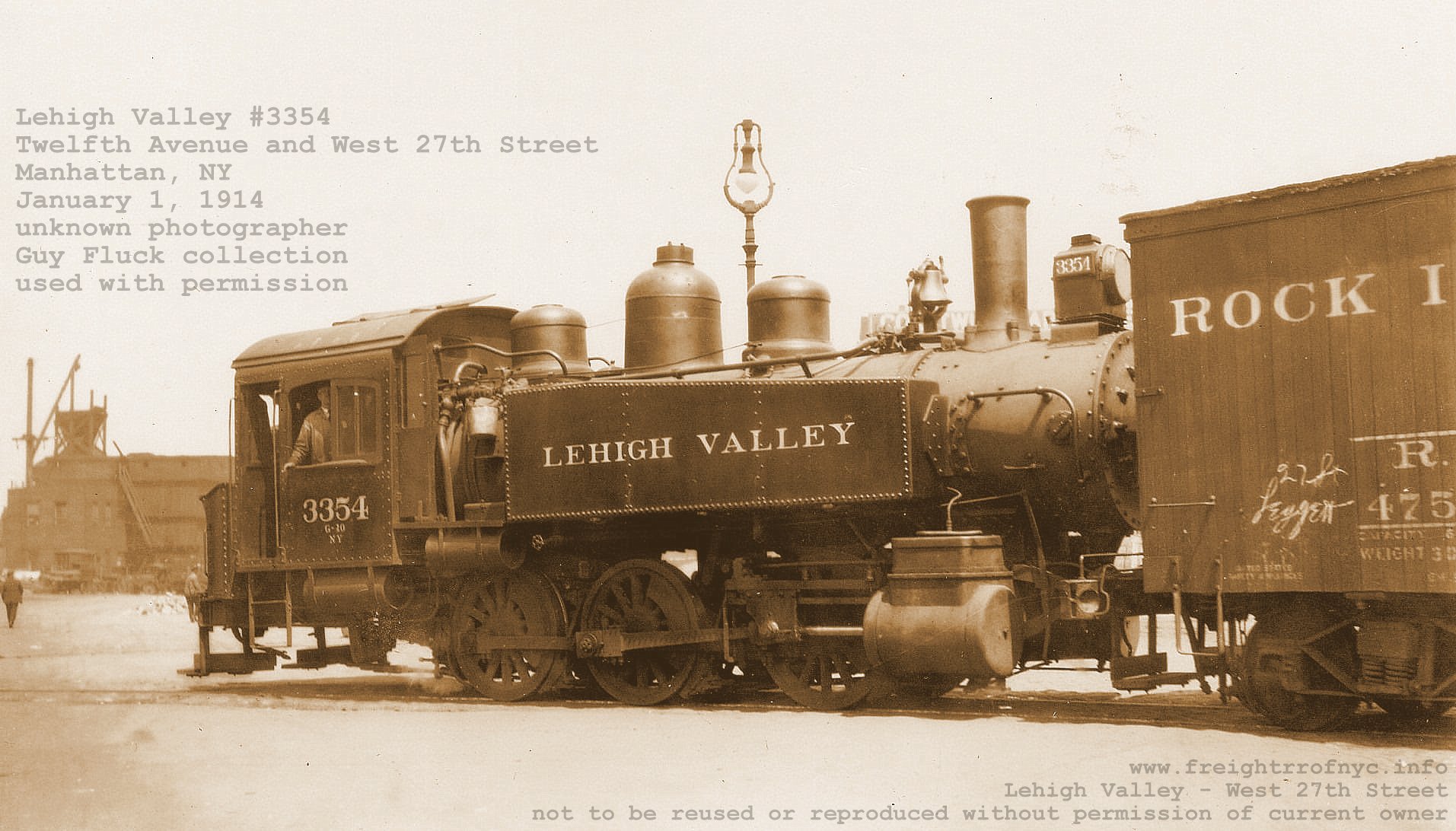 #3354 - January 1, 1914 - Twelfth Avenue, Manhattan, NY
Of particular note is the blind center driver and the sublettering on cab "G-20" and "NY", with G-20 denoting the locomotive class and NY as the assigned work area. Also note the chalk writing on the boxcar: "27 St" and "Leggett". Leggett & Company was a food products, as well as pharaceuticals, chemicals and insecticide manufacturer located in Manhattan. Also note the light standard over and behind locomotive which confirms street running. unknown photographer Guy Fluck collection added 07 April 2021 |
| .
. |
|
|
| .
. |
|
|
| .
. |
|
|
| .
. |
|
|
| .
. |
|
|
| .
. |
|
|
.
.
West 27th Street Freight Station
(LV) Locomotive Roster
| number / name | builder | c/n | build date |
gauge |
wheel arrangement |
wheel dia |
model | cylinders |
acquired |
disposition |
notes | ref |
| #3261 | LV South Easton Shops | 1892 | std. | 0-6-0T | new | scrapped 1/1919 | built as #647, renumbered 3261 in 1905. Outfitted with "all over" cab over boiler, and used as inspection engine until 1917, at which time it was assigned to switching service in NYC. |
|||||
| #3500 | ALCo | 40785 | 6/1906 | std. | 0-4-0T | 48" | 16" x 24" | new | scrapped 8/1939 | unconfirmed if used at W27 Freight Station but did work Bronx Terminal | [1] | |
| #3354 | Baldwin | 11545 | 1/1891 | std. | 0-6-0T | 50" | 20" x 24" | new | scrapped 9/1951 | original #563; renumbered 3354, 1905 | ||
| #100 | AGEIR | 65981 / 9683 |
1/1926 | std. | B-B | 60 ton | new | scrapped 12/1947, Sayre , PA |
[a] | |||
| #110 / #50 | Mack | 173001 | 12/1929 | std. | C | AY | new | scrapped 11/1946 | unconfirmed if used at W27 Freight Station | [10] | ||
| #111 / #51 | Mack | 173002 | 12/1929 | std. | C | AY | scrapped 11/1946 | [10] | ||||
| #112 | EMD | 874 | 8/1939 | std. | B-B | SW1 |
Locomotive Footnotes:
| [a] |
|
.
.
Being a Lehigh Valley Railroad operation; the Pier Stations and float bridge would have been serviced by Lehigh Valley Railroad tugboats, carfloats and lighters.
Keeping in mind the significant fleet of marine equipment that the Lehigh Valley Railroad owned and operated, a Marine Roster on this website would not be beneficial or justified; and therefore will not be forthcoming.
.
Like what you see? Suggestions?
Comments?